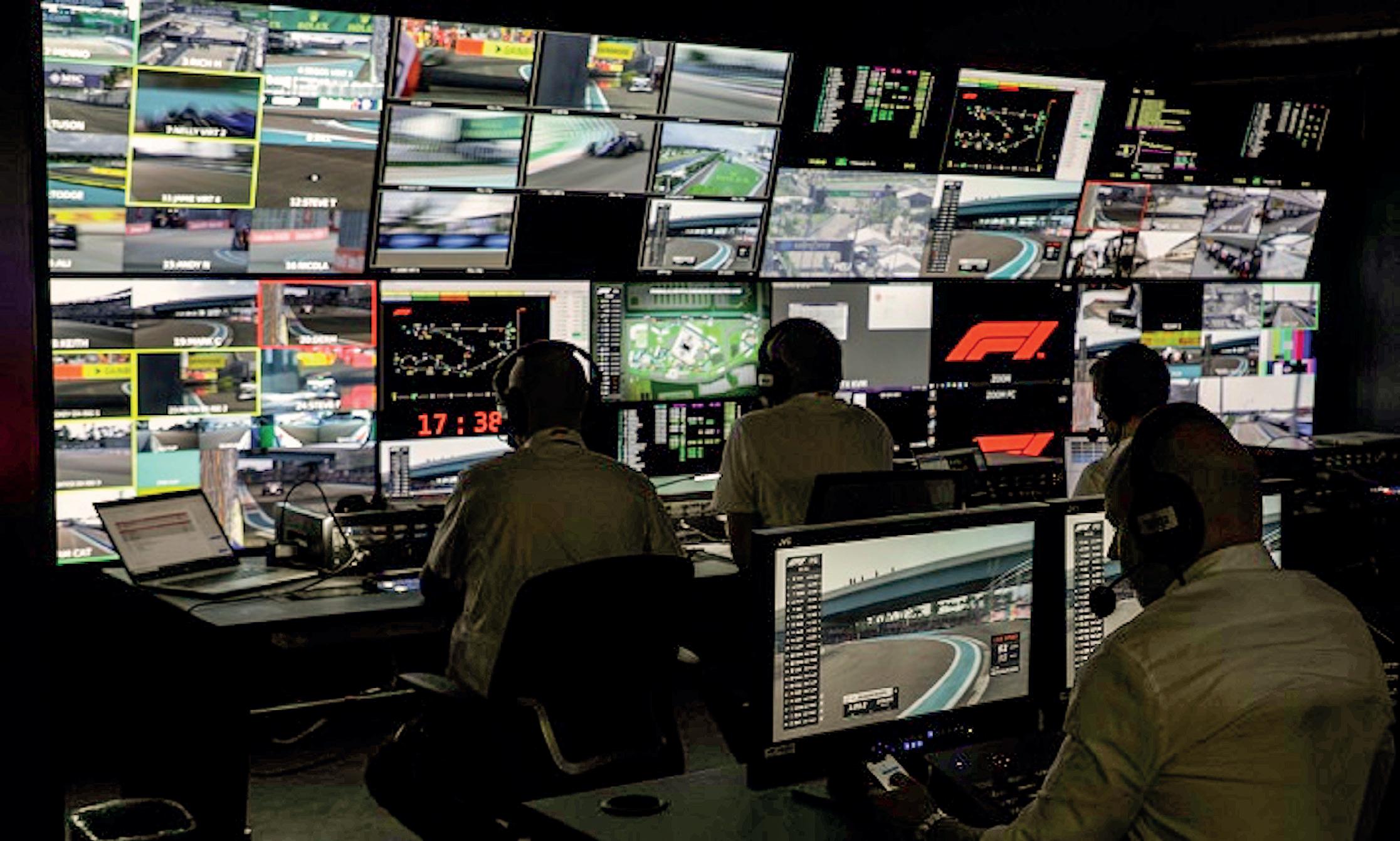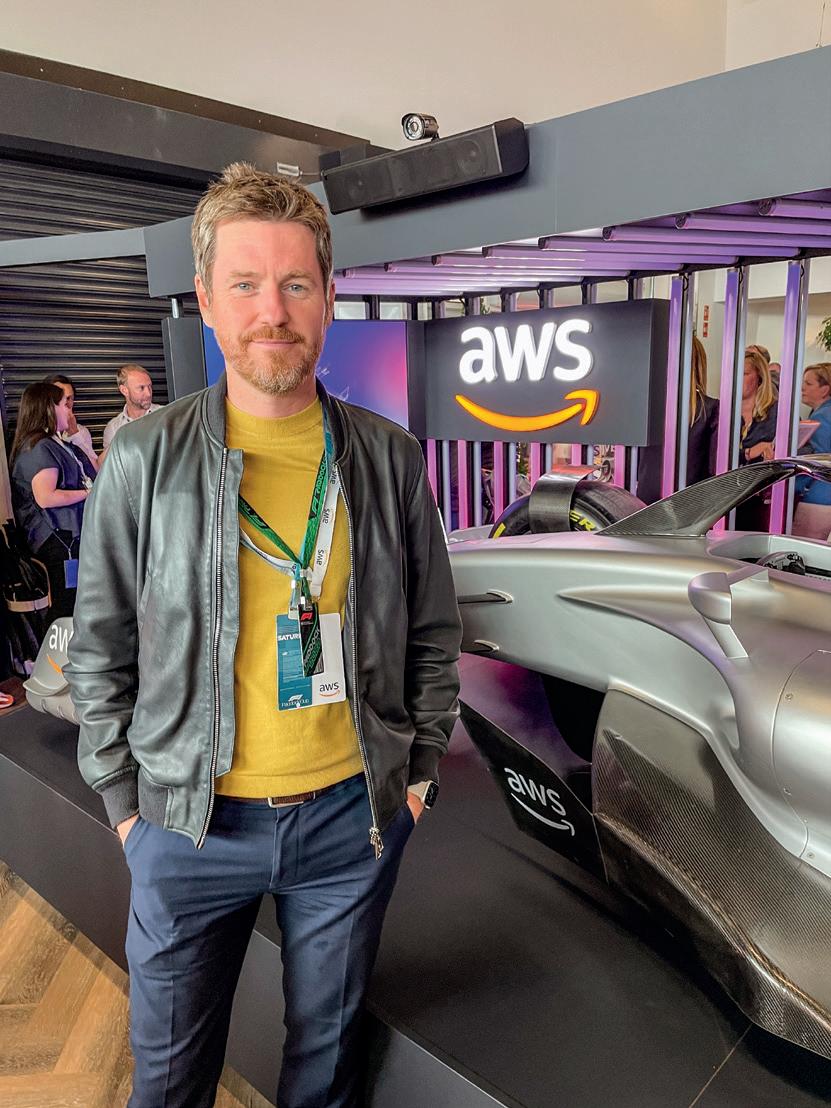
8 minute read
Formula 1
Inside the F1 Media Centre Credit: Formula 1
Live from Silverstone: The inside track on F1’s innovation aims
BY GEORGE BEVIR
FIRST PUBLISHED 6 JULY 2022 A record crowd of more than 400,000 watched an action-packed few days of Formula 1 racing at Silverstone last weekend (1-3 July 2022), culminating in Ferrari’s Carlos Sainz winning his first F1 Grand Prix.
Those watching in the 180 territories around the world where F1 is aired were kept up to speed by the efforts of director of broadcast and media Dean Locke and his team who produced the world feed for some 80 broadcasters.
While F1 fans may have been focusing on the various upgrades to cars introduced by many of the teams at the weekend, Locke says they aim to roll out something new for viewers at every race.
“Stefano [Stefano Domenicali, Formula One Group chief executive] and Ross [Ross Brawn, Formula One Group managing director] are technical innovators and pioneers in F1, so they want innovation literally all the time,” he says. “When we’re on the plane to the next race they will often ask me, ‘what have you got new this week?’”
Those keeping in touch with the racing at Silverstone on Friday via broadcast and social media would have seen the rollout of the pedal camera, which might have been familiar to some viewers.
For Friday’s practice session the camera was placed in the footwell of Lando Norris’ McLaren. The aim, says Locke, is to get viewers closer to the action. “Unlike MotoGP or some other forms of racing where you can see every movement, we have a driver sitting in a car with a crash helmet on and you can’t see much of them.
The limited number of channels that can be fed from the car meant the pedal cam was removed following the Friday practice session in favour of the helmet camera for qualifying on Saturday and the race on Sunday. Currently, the media team can run 90 cameras across 20 cars, with approximately 20 cameras switched on.
“What that means is we can have one camera for each car switched on, forward or rear. But we can also dualstream on several cars, but that very much depends on the nature of the circuit,” says Locke.
In terms of the total number of cameras, the race at Silverstone was covered by some 26 track cameras, 10 in the pit lane made up of a mix of fixed cameras, RF roaming cameras and a cable camera, along with a helicopter and cameras buried in the curbs. Together with cameras covering the press conference — and those in the cars — the total number was in the region of 60-70.
Updates to audio acquisition are also planned. At present, there are 150 microphones placed around the course to capture the sound of the cars and crowd. “We’ve spent a lot of time over the last couple of years looking at audio around the car and we’re just designing some
DEAN LOCKE, FORMULA 1 new on-car systems. We want extra audio channels and microphones on the car to pick up their sound,” says Locke, who says the rollout could be affected by component shortages. “Lead times just seem to be getting longer,” he says. “I’d love to see it rolled out next year, but it’s a massive project.”
Data and GFX
As well as enhancements designed to immerse viewers in the action, Locke and his team are also working on ways to better explain the intricacies of F1 races. He says: “Graphics in F1 are really hard, because we have this very complicated sport and a diverse fanbase; we have really hardcore fans really into data and strategy that might feel aggrieved if you explain things in simple terms, but we also have this massive drive for new fans as well, with a young demographic we need GFX to explain things to them.”
F1 struck a deal with Amazon Web Services (AWS) in 2018 to host the motorsport’s data centres and provide machine learning and data analytics services. As part of this, AWS also works with F1 on its series of F1 Insights tools, on-screen graphics designed to help viewers understand particular elements of the sport, including race strategy, competitor analysis and car performance.
At Silverstone, the F1 Insights team debuted Projected Knockout Time, a new tool focused on qualifying, that uses predictive models that take into account all the conditions and historical data to provide information about how each driver will perform during each stage of qualifying and what times they need to achieve.
“We start with problems,” says Locke. “For example, we might have a low point in a race where it may get a bit quiet, but we want to encourage people to stay tuned. So we did some modelling around how long it might take a particular driver at their current pace to catch the person in front, taking into account things like tyre degradation, and we throw that into the model.” That resulted in the F1 Insight ‘Battle Forecast’, which provides a prediction as to how many laps it will take for a chasing car to catch the car in front.
F1’s relationship with AWS also covers distribution and is likely to be expanded in the near future, Locke says. “We have always used AWS for our F1 TV product. The distribution of that sits with AWS in the cloud, but how do we take that further? We would like to do that with our world feed signals as well moving forward, I think, and that’s something we want to move on to pretty soon.”
F1’s drive to provide curated viewer data feeds
Formula 1 is looking to provide bespoke data feeds to serve the needs of viewers with varying levels of technical knowledge of the sport, according to F1 director of data systems Rob Smedley.
Smedley says the biggest barrier to boosting fan engagement among new and casual F1 viewers is the highly technical and complex nature of the sport which often needs explaining.
“When it comes to deciding what data to show and how much, it’s a fine balance and, like any decent business, we have to listen to our customers,” he says.
Smedley, an F1 engineer who previously worked with the likes of Williams and Ferrari, says his role now is to act as “the glue” between F1 and Amazon Web Services (AWS).
“The way to avoid overloading with data is to make it a more bespoke experience for everybody, because there is only so much that we can put on a linear feed, so we have been thinking about that and pushing ideas around,” he says.
“[Data] should be an interactive choice and that is something that we are looking at for the future. At the moment, I think we have the balance right with how much data we show on the screen, because we can’t overload it and that comes from listening to the broad demographic that watches F1. However, where we need to get to is second and third screen devices so people can have their device and say, ‘I want to curate my data experience in such a way which is completely bespoke to me’.
“We’re at proof-of-concept stage. It has been talked about for a long time, but there are all sorts of complexities to it.”

Rob Smedley, F1 director of data systems
Wet weather
Smedley spoke with SVG Europe on Saturday (2 July 2022) during qualification at Silverstone, when the F1 Insights team debuted a new tool focused on qualifying. The Projected Knockout Time tool aims to predict the time that teams need to reach in order that they pass through to the top 15 in Q1 and the top 10 in Q2.
“We try to use predictive models that take into account all the conditions and historical data, driving models, car models and say right, this is how we think everybody will pan out at the end of this particular qualifying session, or that is the lap time that all of the teams have to beat.”
However, while eventual race winner Carlos Sainz was able to take advantage of the rain on Saturday to claim his first ever pole position on his 151st attempt, the wet weather did not provide ideal circumstances for the launch.
F1’s Dean Locke later explained that the rain had affected the tool. “It ran, but we ended up running it a little less because of the rain, because it affected the model so we held back on it and we’ll roll it out properly in Austria [the next race in the calendar, on 10 July],” he explains.










